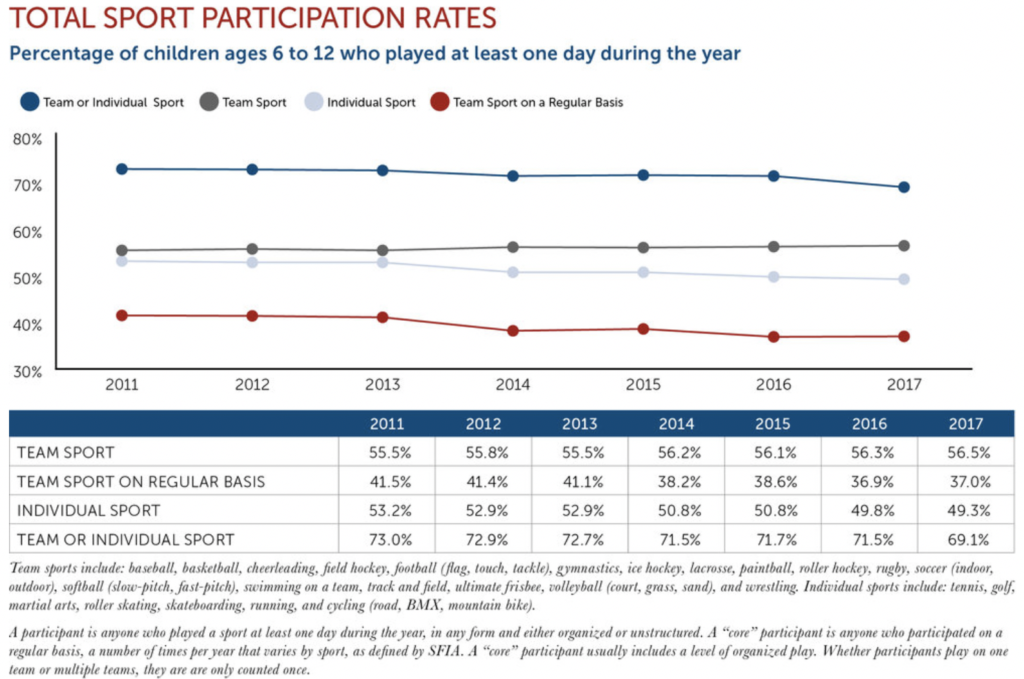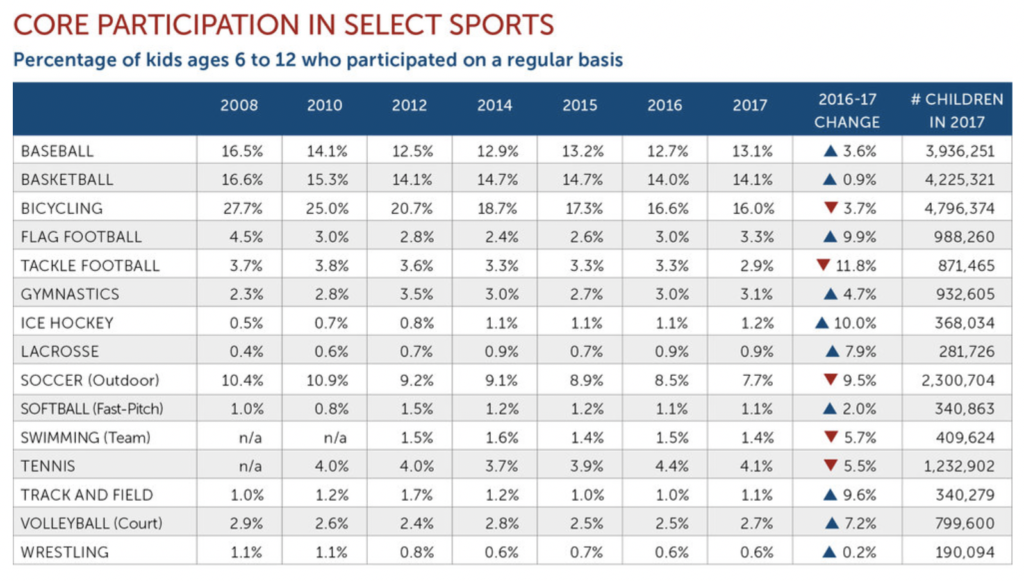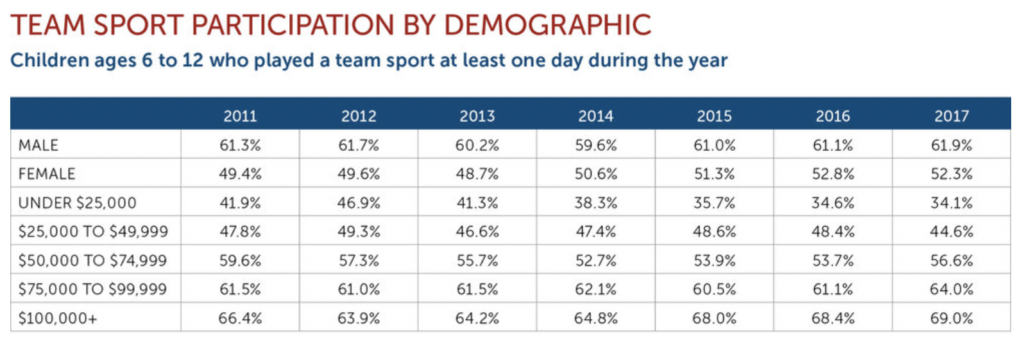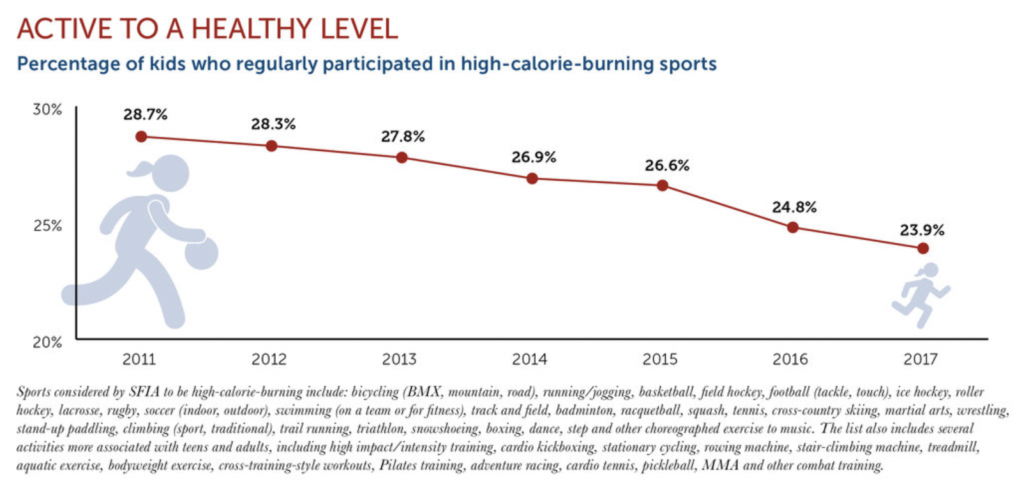Blog: No Brainer: Youth Sports Participation Rates
According to a recent report by the Sports & Fitness Industry Association (SFIA) and the Aspen Institute, youth participation in most team sports was up slightly in 2017, but was down 4% over the past four years. A decade ago, 45% of children ages 6 to 12 played a team sport regularly, but now only 37% of kids do so. But why?
The reasons for the decrease in sports participation in general include concerns over injuries, in particular concussions and other brain injuries, poor coaching, the high cost to participate, the increase of elite travel teams, and the increase in video game playing which competes for a kid’s time.
The biggest participation decrease was in tackle football (down 11.8% last year), with soccer having the next biggest decrease of 9.5%. The SFIA reports that in 2017, the number of students playing high school football fell for the fourth straight year to 1.07 million, down 20,893 players, at a time when participation in some other sports is growing. According to the National Federation of State High School Associations, the number of athletes playing high school football has gone down about 5 percent since 2011, and for youth players ages 6-12, participation in tackle football has decreased 17.4% over the past five years.
A recent research survey found that 78% percent of American adults do not think kids younger than 14 should play tackle football. The survey’s three main findings include:
- There is widespread awareness that concussions are caused by sports and represent a significant public health issue.
- The majority of Americans want changes to youth sports, including banning tackle football and heading the ball in soccer until high school.
- Professional, college and national sports organizations don’t do enough to address the concussion issue in sports.
This decline in tackle football coincides with public debates over the safety of the sport and medical research showing the harm that can be caused by concussions and repetitive hits to the head. This past year, state legislators in in California, Illinois, New York, and Maryland introduced legislation proposing minimum ages of 12 years or older for tackle football participation. In addition, the Concussion Legacy Foundation, a Boston-based brain trauma research nonprofit, launched a public education program that urges parents not to enroll their children in tackle football before age 14 for health and safety reasons.
There has been resistance to some legislative attempts to ban youth tackle football. In California, legislators were unsuccessful in pushing a bill called the “Safe Football Act” that would ban youth tackle football for children under age 12. Another unsuccessful bill would have barred students from playing tackle football until high school. There is new legislation backed by youth football advocates that limits youth programs to two full-contact practices a week capped at 60 minutes per day, as well as a ban on full-contact during the offseason.
However, while tackle football is down, flag football participation is up 38.9%, reflecting the trend towards a safer version of the sport. In 2017, flag football passed tackle in popularity among kids ages 6 to 12 for the first time (when 100,000 more kids played flag than tackle).
The Aspen Institute wrote a white paper that analyzed the consequences of this trend towards flag football, and focused on the following questions: (1) Would delaying tackle football until high school make players safer? (2) Would flag football bring more children into the sport, or drive them away? (3) What impact, if any, would there be on high school football? (4) What could this mean for the NFL and college football in terms of talent development, fan cultivation, and long-term bottom line? (5) How would a shift to flag football impact the values through the sport? The paper concluded that children, football and communities are likely to benefit if flag football is the standard way of playing until high school.
The following charts are from the SFIA’s most recent report, State of Play: 2018. The State of Play report focuses on kids ages 6-12 and showed five key developments:
- Slightly More kids are physically active, but not active enough. 17% of children engaged in no physical activity. While this is down from 19.5% in 2014, it is still a high number of inactive kids.
- Most team sport participation is up, but offset by declines in football and soccer. In 2017, 56.5% of kids played on a team sport at least one time during the year, slightly up. While participation is up in many sports, it is down in tackle football (down 11.8%) and soccer (down 9.5%). In comparison, participation is up 9.9% in flag football, up 9.6% in track and field, and up 7.9% in lacrosse.
- Multisport play is slightly up but still historically down. There is a slight improvement that children on average play 1.85 team sports; however, this is still down from the level in 2011 where the average child played 2.11 sports per year.
- Most youth coaches are not properly trained. Only 35% of coaches are trained in core competencies such as basic skills, and 36% are trained in strategy and safety and injury prevention.
- The cost of sports is increasing. The higher costs and dropping participation can be attributed to an “up or out” or “pay to play” mentality created by competitive travel teams, which can cost thousands of dollars to join. As players develop, the better ones are often “recruited” to play on competitive travel teams, and those who don’t make a team will often quit the sport, and either try something else, or quit team sports altogether. This has mostly affected kids from lower-income homes and is a barrier to participation.
While youth sports participation is down is some sports, it is encouraging to see that participation is up in other sports and that steps are being taken across all sports to improve player experience. The next blog will explore ways some sports are revitalizing their player experience and what else can be done to ensure the growth and safety of youth sports.




